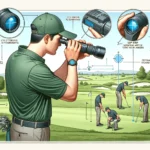Comprehensive Golf Club Distance Charts by Age, Gender, and Skill Level
Golf requires precision, and knowledge of your yardages with each club in the bag is a big part of the game. And in this guide, we are going to see golf club distances based on age, gender, and ability levels. The main performance factors of swing speed, smash factor and more will also be analysed.
How long do you hit the ball? How do you compare to others? Remember, things like age and gender and skill are so important here, so don’t compare yourself in an unrealistic manner. I just wanted to share the most up-to-date with you in all its good intentions so I took the time to write this article.
Golf distance insights tables and charts: Quickly skim through them. The charts provide some of the primary measures of how far you are able to hit each of your clubs (for many of you):
- Swing Speed
- Ball Speed
- Smash factor
- Quality of your equipment (dedicated page)
- Optimization of your equipment
These measures are influenced by how you are built, your ability level, your age, and your strength, flexibility or limitation levels. In general you can become significantly better in each of these areas with practice or coaching so this is a reassuring sign as it shows you have much more control than you might initially think.
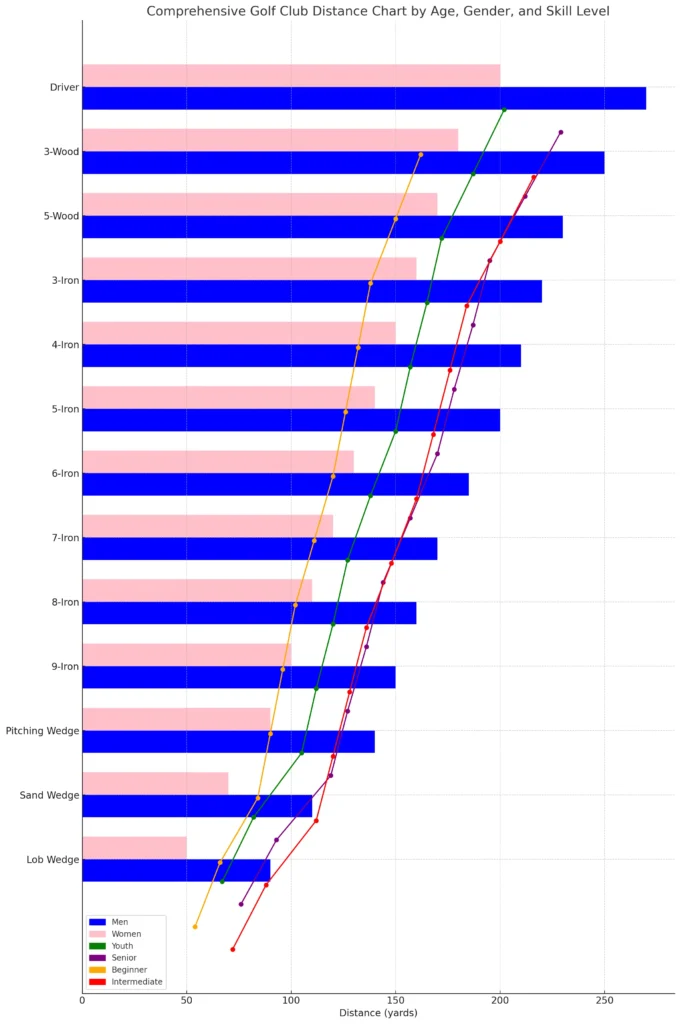
Table of Contents
Golf Club Distance Chart by Swing Speed
Swing speed can drastically affect your golf club distances. The fact that the only thing that matters, of course, will not make the ball Triton NexGravity golf AttasTSY when 100 persons hit this way — but at least the fastest sticks will benefit the ball further.
Well… for the most part, golfers tend to average around 90 mph driver swing speed. Around 114 mph for the average swing speed on the PGA Tour. Only the long drive competition folks will be swinging hard enough to get up to that top range of 150 mph.
Distance of Each Club by Swing Speed
The following table shows the average distances per club based on your swing speed.
NOTE: The swing is based on driver swing speed at the top of each column. We use it more as a general guide to gauge how far the next club is going to go.
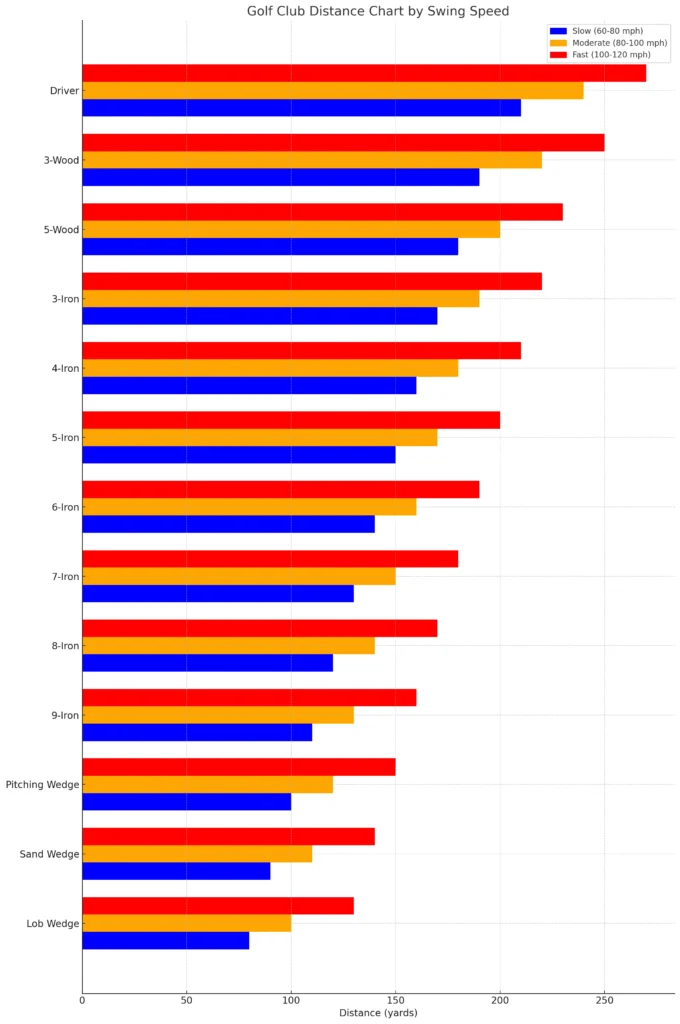
Tips to Increase Your Swing Speed
Generating a high swing speed can greatly help you hit the ball farther. An exercise you can do to help in speeding up your weight loss journey is strength training and there are several great strength training exercises you can try, some of them include:
- Strength Training: Using exercises that help build your core, leg, and upper body strength to help with increasing how fast you recover.
- Flexibility: Adds in stretches and yoga to help with flexibility.
- Swing Mechanics: Have a professional coach optimize what you do.
- Right Gear: Make sure your clubs are tailored to your swing style and to your very own physical stature.
You are the numbers in the chart but you want to be the new ball. Just about all of us do, and there are 3 ways to swing the club faster:
Take lessons on proper mechanics from a pro swing coach. He uses all of your body elements and constraints that will make you hit the ball right in the center of the club face. If you can do it right, you can gain up to 10 mph of driver swing speed.
Get stronger and more mobile in the gym. You will increase your swing speed with a combination of strength training and mobility work with a trainer, there is no way you do not. More flexibility in the muscles will be a major way to improve this, but additional strength will directly translate to more speed. Depending on your level of strength and mobility, you can likely gain 10-20 mph in your swing!
Have lighter golf gear adapted to your swing. In addition, lighter shafts may help boost swing speed anywhere from 2-5 mph.
This is the only way your swing speed will improve but the ONLY way is the coaching and practice, so you will then be able to HIT THE SWEET SPOT of the club, and this is the most important factor. It’s when you give the ball everything you’ve got with the center strike, and we measure how well you hit the ball with the Smash Factor.
Understanding Smash Factor in Golf
The ratio of ball speed and clubhead speed is called SMASH FACTOR. The thing was optimizing this metric so it performs better. A higher smash factor means the club is effectively transferring energy to the ball better.
Smash Factor = ball speed / club speed Ex: 150 mph in ball speed / 100 mph in swing speed = 1.50 Smash Factor.
This ratio is then used to provide a sense of how the energy is transferred from the club head to the golf ball upon impact. Low Smash Factor numbers indicate that you are not transferring much energy while higher Smash Factor numbers show that you are getting more of the energy out of your golf club into the golf ball. Smash Factor: 1.50 (optimum for excellent driver ball striking)
Optimal Smash Factor for Every Golf Club
The PGA Tour players are the best in the world, so we can take their averages to be top-of-the-line numbers to estimate the best, state-of-the-art smash factors in the world. You are smashing it THIS WELL according to Trackman. You can see the smash factor decreases as the loft goes up.
PGA Tour Smash Factor by Club
Impact of Skill Level on Smash Factor
Distance is impacted by the swing speed but MOSTLY the efficacy of the strike particular to that swing speed.
Translation: How near the face of the club that you hit the ball, will limit how your swing speed power will transfer into the golf ball. A professional swing coach can help you hitting the ball in or at least very near the middle of the face.
This is going to get your current swing speed and get it to perform better by getting more out of where you hit the ball on the club. We measure how well you hit with something called Smash Factor.
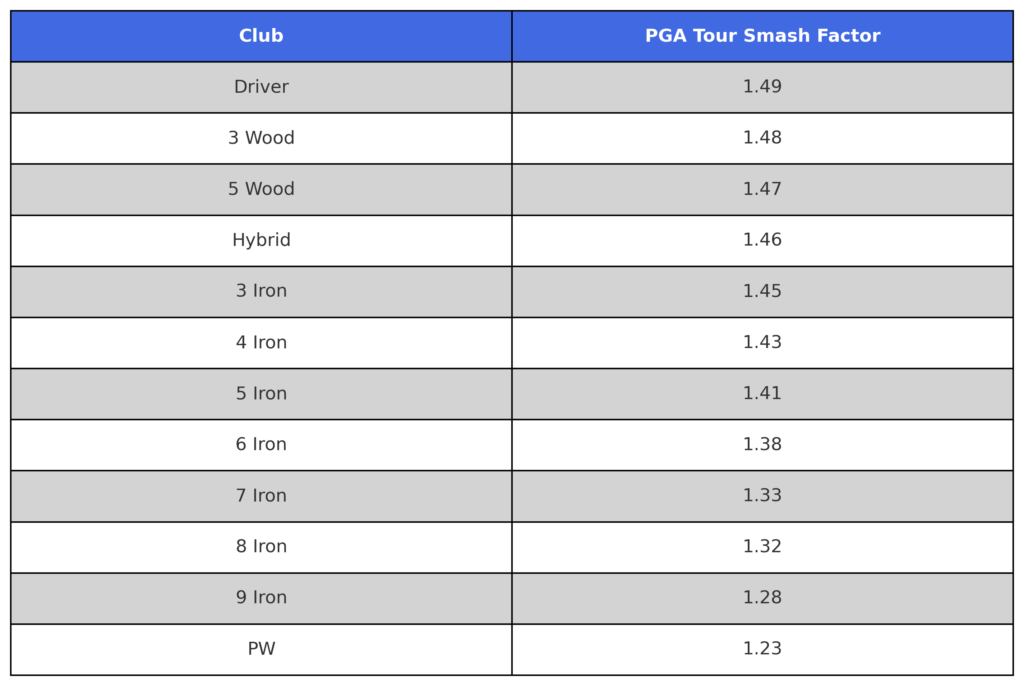
How Equipment Influences Swing Speed and Smash Factor
The players at the highest tier of the competitive game have had their equipment tailored to their swing and skill level along with body proportions and muscle. That same swing speed in a PGA Tour pro or Golf Breaks Scotland will send the ball a good deal farther than it would in the case of an amateur golfer who has similar swing speed tendencies but a much higher handicap. The PGA Tour player’s swing is flawless, so if your swing and a Tour pro’s swing are the same and you both hit the ball at the same distance, the pro still hits it further because their equipment is perfectly tailored for their swing.
The following are other aspects you might consider changing to increase swing speed club:
Club Weight: Swishing lighter clubs can certainly help you increase club head speed.
Club Design: Current views see the smash factor as key, and clubs are designed around maximizing it.
Ball Technology: High-quality golf balls are designed to improve your smash factor and overall performance.
Average Golf Club Distances for Male Golfers by Skill Level
From ‘Good Golfer’ on, the 2-iron down to the 5-iron should get better as confidence and technique grow, therefore more swinging speed. Entry Level Golfer: Green horn of the game — 6–12 months on the course.
Average Golfer: 15–24 handicap.
Good Golfer: 6–14 handicap.
Superior Golfer: Single digit golfer, handicap below 6.
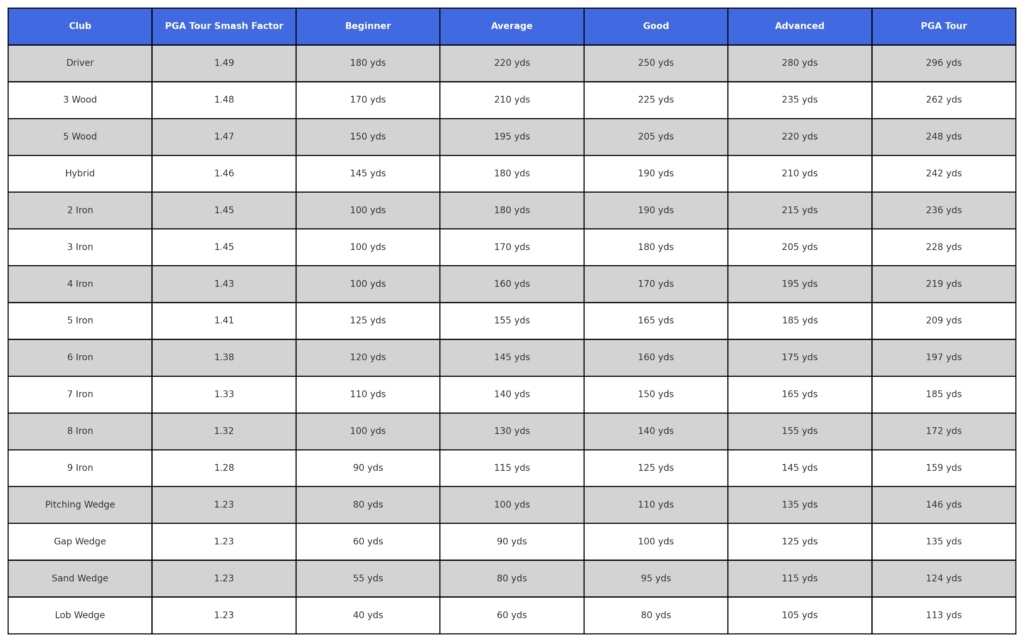
Swing Speed Charts by Age and Gender
How quickly (swing speed) is therefore the biggest factor in how far you can hit the ball. The swing speed since hitting the center of the club face will send the shots further. So a High speed swing that strikes the ball poorly is going to travel a lot less in distance.
A professional golfer golfing at the same swing speed as an amateur will generate vastly different, but those pro will strike the ball middle of the face all the time.
That means if you want to add some distance with the same swing speed, you can focus on hitting the ball closer to dead center on the face.
Detailed Swing Speed Analysis by Age and Gender Chart:
Data from TPI identifies average 50th percentile driver swing speed by male and female according to age group.

| Age | Men | Women |
| 10-16 years old | 93 mph | 83 mph |
| 17-29 years old | 113 mph | 93 mph |
| 30-50 years old | 103 mph | 85 mph |
| 50-60 years old | 99 mph | 74 mph |
| 60+ years old | 93 mph | 73 mph |
Driver Swing Speed Chart by Golf Skill Level
Hitting the driver more accurately and out the sweet span will depend upon confidence and skill. Novices with a driver will be imaginably versus utilizing various other mechanic.
COMPETITION & TOURNAMENTS Experience or lessons will make mid handicappers better at the driver. Skilled golfers are those who hit a lot of balls and have effectively taken a couple of lesson from a pro.
The very tip of the spear without a doubt is on how PGA Tour golfers have fine-tuned every aspect of the game with the driver.
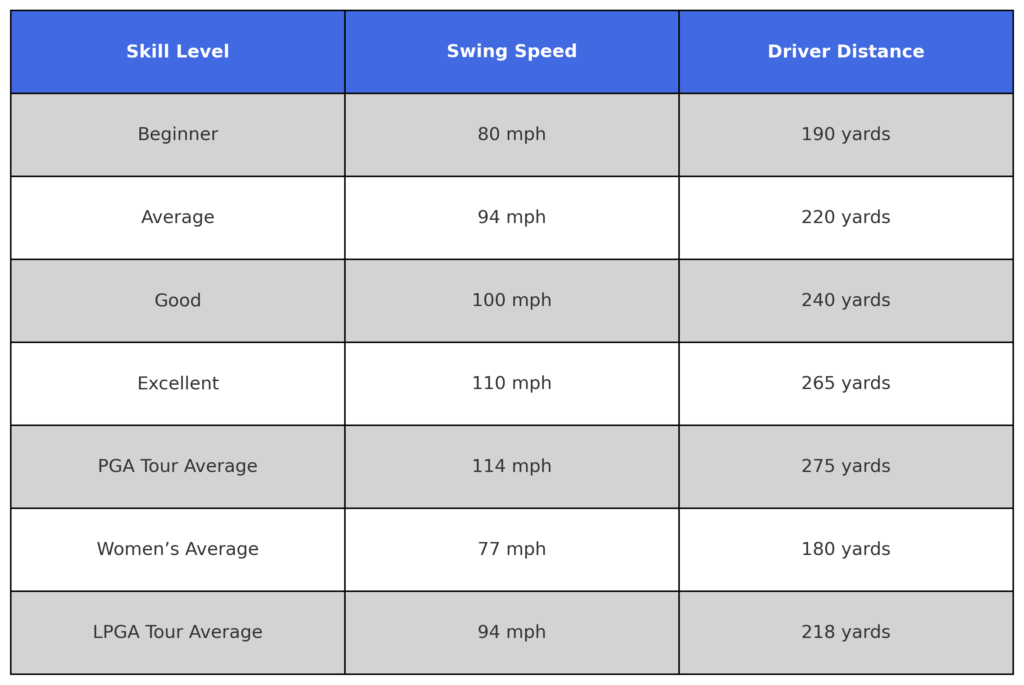
| Skill Level | Swing Speed | Driver Distance |
| Beginner | 80 mph | 190 yards |
| Average | 94 mph | 220 yards |
| Good | 100 mph | 240 yards |
| Excellent | 110 mph | 265 yards |
| PGA Tour Average | 114 mph | 275 yards |
| Women’s Average | 77 mph | 180 yards |
| LPGA Tour Average | 94 mph | 218 yards |
Is a 250 yard drive good?
In fact, depending on data source, between 15% and 31% of golfers can crunch it 250 yards or further — have at it, Arccos and Shotscope.
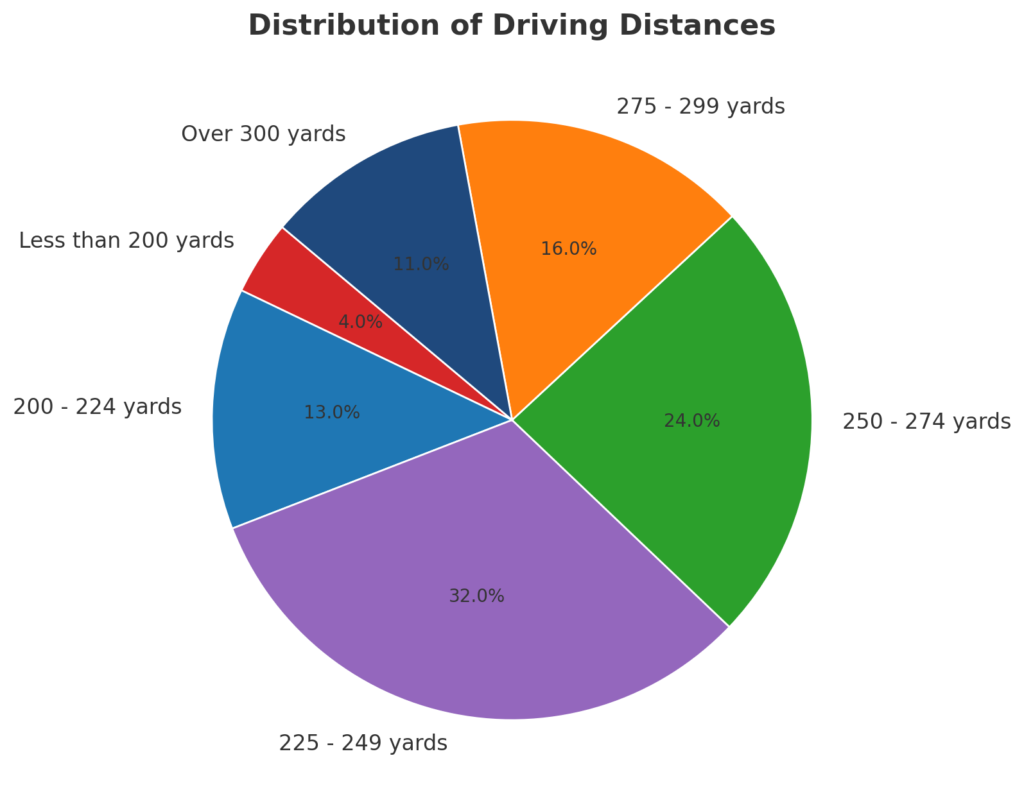
Ball Speed to Club Head Speed Chart for Drivers
Ball speed exiting the face of the driver is strike dependent. If you Strike or Smash Factor (which is how you strike the ball) is good, you will be able to get more distance out of your swing speed, than you will with the same speed and a poor strike.
Here, we will use the club head speed and apply a Smash Factor of about 1.42 as that is 0.08 away from a perfect strike.
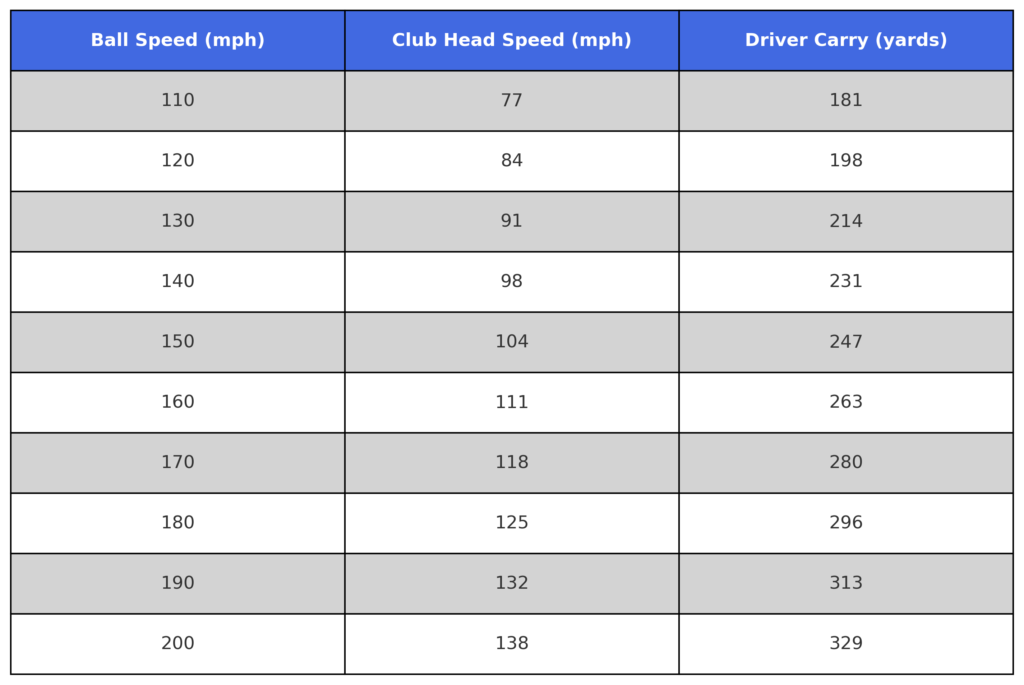
Ball Speed (mph) | 110 | 120 | 130 | 140 | 150 | 160 | 170 | 180 | 190 | 200 |
Club Head Speed (mph) | 77 | 84 | 91 | 98 | 104 | 111 | 118 | 125 | 132 | 138 |
Driver Carry | 181 | 198 | 214 | 231 | 247 | 263 | 280 | 296 | 313 | 329 |
Required Swing Speed for 250 Yard Drives
With a driver swing speed around 105 mph, and a resulting ball speed around 150 mph, that’s a 250 yard drive.Ball Speed to Club Head Speed Chart for 7 Irons
The smash factor of a 7 iron is best around 1.33. That is the PGA Tour average. Note: For the driver it is 1.50. The 7 Iron Ball Speed is determined by Swing Speed and Smash Factor.
The target smash factor actually shifts as the clubs get shorter.
How far will a 7 iron go at each swing speed?
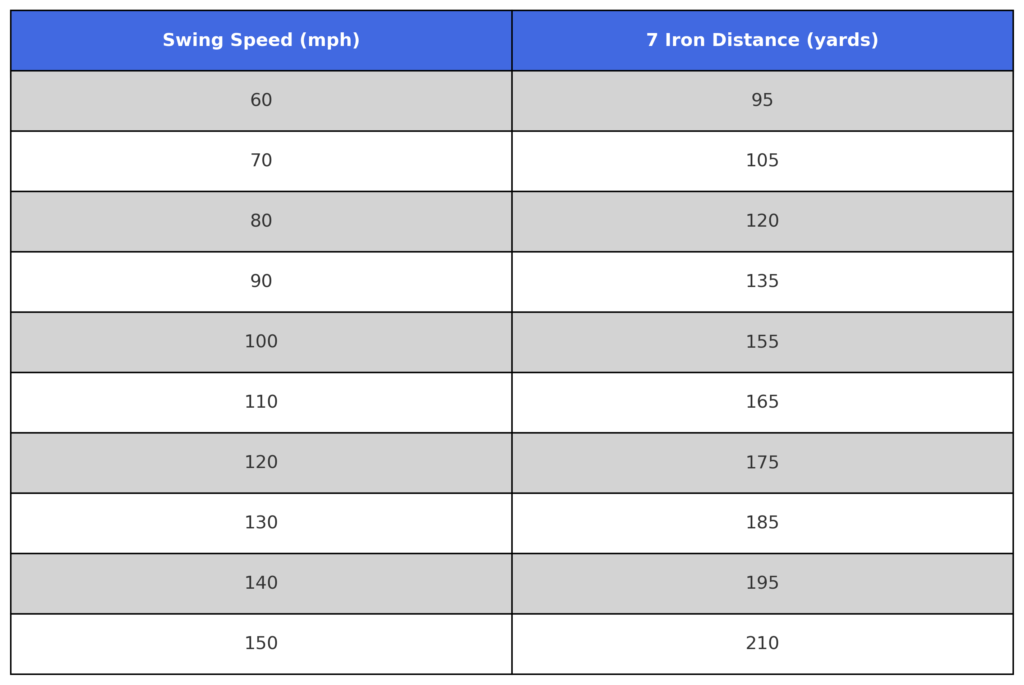
7 iron distance by driver swing speed | |
Swing speed | Distance |
| 60 mph | 95 yards |
| 70 mph | 105 yards |
| 80 mph | 120 yards |
| 90 mph | 135 yards |
| 100 mph | 155 yards |
| 110 mph | 165 yards |
| 120 mph | 175 yards |
| 130 mph | 185 yards |
| 140 mph | 195 yards |
| 150 mph | 210 yards |
Required Swing Speed for a 150 Yard 7 Iron Shot
The kind of shot that will go 150 with a 76 mph 7 iron swing, 105 mph ball speed, and 21° dynamic loft.
Golf Club Distance Charts Other Important Factors
Loft | Every club has different loft and more loft goes less distance while less loft goes longer distance with longer golf shaft.
In general, the driver is going to go the farthest and a lob wedge of about 60 degrees is going to go the shortest of any club.
Clubs | Average Lofts 2022 | Average Lofts 1990 |
Driver | 8° – 13° | 9° – 14° |
3 Wood | 13° – 15° | 15° – 17° |
5 Wood | 20° – 23° | 21° – 24° |
2 Iron | 18° – 20° | 20° – 22° |
3 Iron | 21° – 24° | 23° – 25° |
4 iron | 25° – 28° | 28° – 30° |
5 iron | 28° – 31° | 31° – 33° |
6 iron | 32° – 35° | 35° – 37° |
7 iron | 36° – 38° | 39° – 41° |
8 iron | 40° – 43° | 43° – 47° |
9 iron | 45° – 48° | 48° – 50° |
Pitching Wedge | 47° – 50° | 51° – 54° |
Today’s golf clubs go a LOT further when the manufacturers of today teamed up cavity back golf clubs along with lower lofts for the same clubs. All the clubs are playing 2 to 5 degrees less loft these days, which instantly adds up to 15 yards per iron in comparison to back in the day. If you push driver lofts any lower people can’t hit them.
A driver with less than 9 degrees of loft requires a very high swing speed in order to properly hit it off the face. For a slower swing speed you should note that you can actually GAIN distance with a more lofted fairway wood or more lofted driver because a lower loft is more difficult to get up in the air at lower swing speeds.
Golfers of all kinds should be playing fairway woods with no fewer than 16 or 17 degrees of loft. The situation with Golf Irons – As you probably know the club heads of all golf clubs nowadays are much bigger and the sweet spot is much larger. The incorporation of lighter shafts in the irons and woods has also lead to faster ball speeds and swing speeds. To see our report on shafts right around the clock, click here.
Why Knowing Your Golf Club Distances Matters
Understanding the distances each golf club can achieve is one of the most important skills for improving your game. It goes far beyond memorizing numbers—it allows you to make smarter decisions on the course, hit more accurate shots, and lower your scores.
Choosing the Right Club for Every Shot
- Golf shots truly are special, and picking the right golf club is a skill unto itself! Knowing your distance helps you decide on the following:
- Knowing which approach shot to take between the 7 and 8 iron.
- Identifying when to grab a hybrid vs a long iron.
- Assessing risk by picking a club that will hit your target.
- Without this, you get guesses which lead to over-calculation, under-calculation, and missing which frustrates the player and increases their score.
Understanding Club Specifications: Loft, Angle, and Measurement Charts
Golf clubs are not all the same. Their lofts, shaft lengths, and angles determine how far the ball will travel. By familiarizing yourself with:
Loft angles – Higher loft = higher trajectory, shorter distance.
Club length and shaft type – Longer shafts and graphite shafts can increase distance for some swings.
Measurement charts – Knowing the standard specifications of each club helps you predict ball flight and distance.
Golf Club Distance Charts of PGA Tour Golfers
Club | PGA TOUR Average | Bryson De Chambeau | Dustin | Rory McIlroy | Tiger | Jack | LPGA Tour Averages |
Driver | 275 | 325 | 312 | 360 | 297 | 250 | 255 |
3 Wood | 243 | 295 | 282 | 325 | 265 | 235 | 230 |
5 Wood | 230 | 275 | 267 | 300 | 245 | 220 | 215 |
3 Iron | 212 | – | – | – | 227 | 210 | 197 |
4 Iron | 203 | 255 | 236 | 272 | 215 | 195 | 186 |
5 Iron | 194 | 235 | 225 | 256 | 200 | 180 | 175 |
6 Iron | 183 | 220 | 212 | 235 | 186 | 167 | 164 |
7 Iron | 172 | 205 | 200 | 222 | 170 | 155 | 153 |
8 Iron | 160 | 190 | 186 | 200 | 157 | 145 | 142 |
9 Iron | 148 | 175 | 172 | 188 | 148 | 130 | 130 |
Pitching Wedge | 136 | 160 | 158 | 169 | 136 | 120 | 118 |
Reasons Behind the Increased Distance of Modern Golfers
Physical Fitness in Golf:
Today, physical fitness is a huge part of the game for the modern golfer, leading to increases in swing speeds and distances.
Golf Club Technology has Evolved:
Golf is now a game of long and straight, and club technology has advanced to maximize both distance and control.
Golf Ball Innovations:
Modern golf balls are engineered to maximize distance, control, and feel.
Conclusion:
Knowing your driver distances as well as the things that will affect those distances and will go a long way in helping you to improve at golf. That way, you can understand things such as swing speed and smash factor, helping you to choose your gear and training that little bit more intelligently and ultimately perform better on the course.

